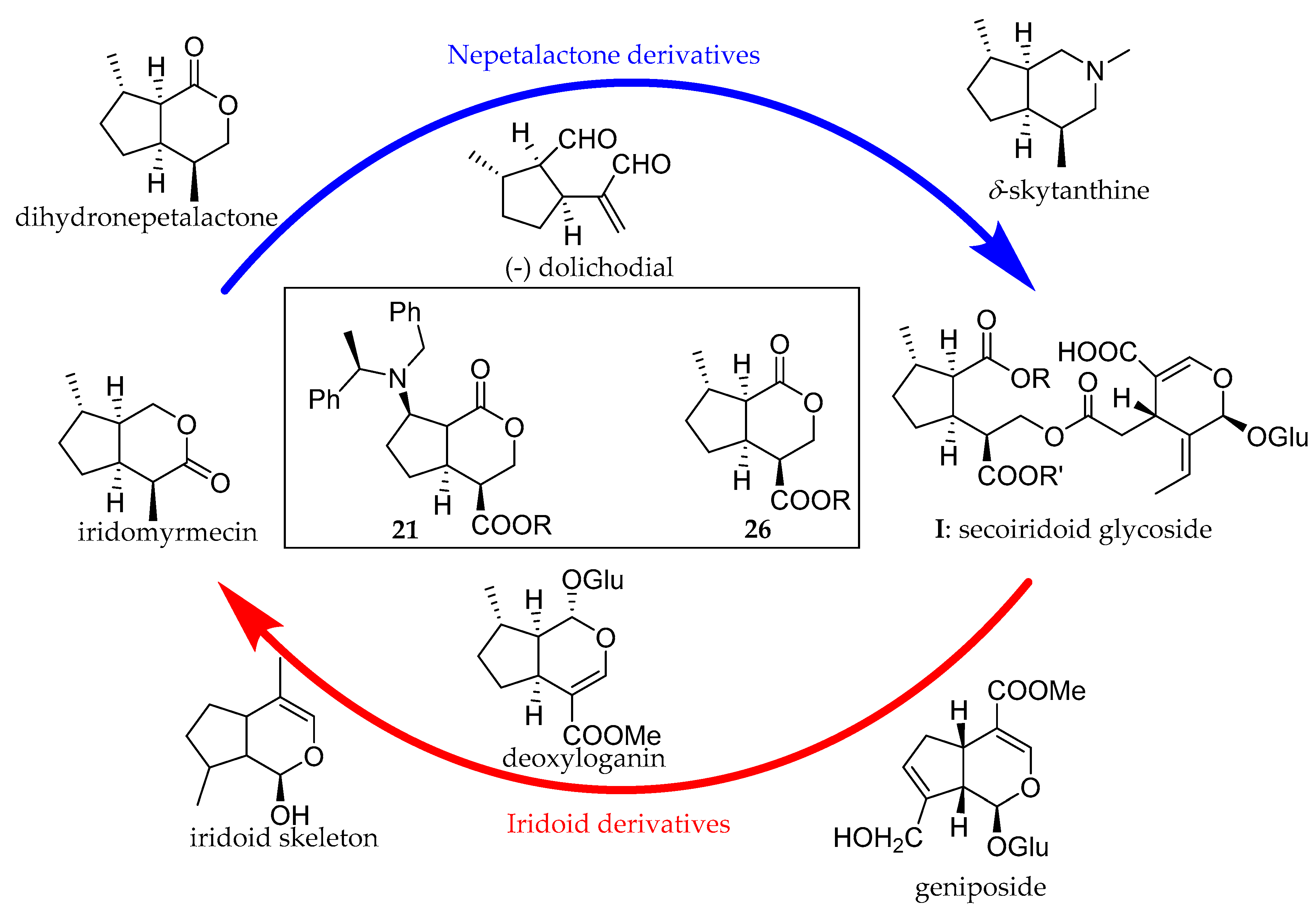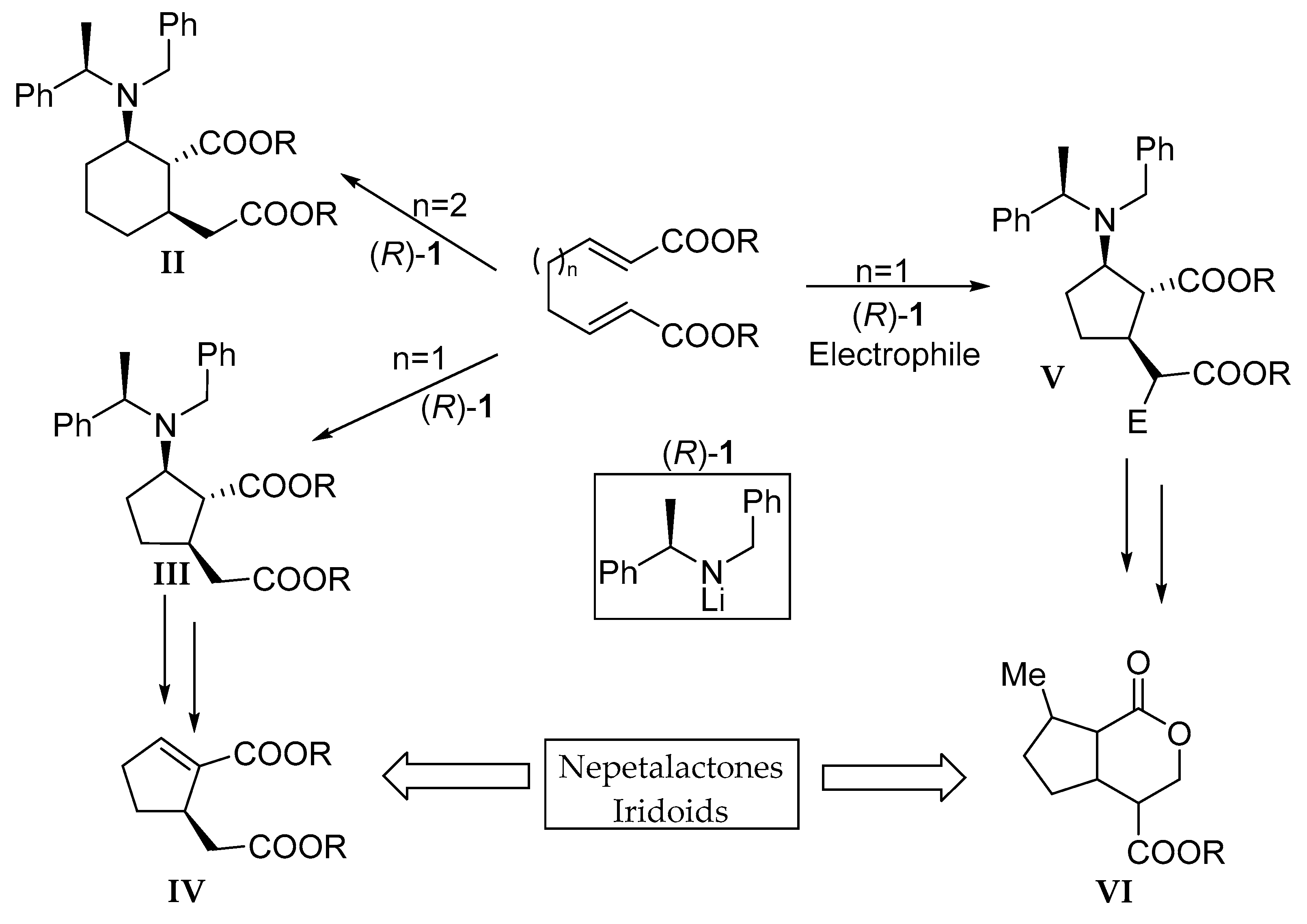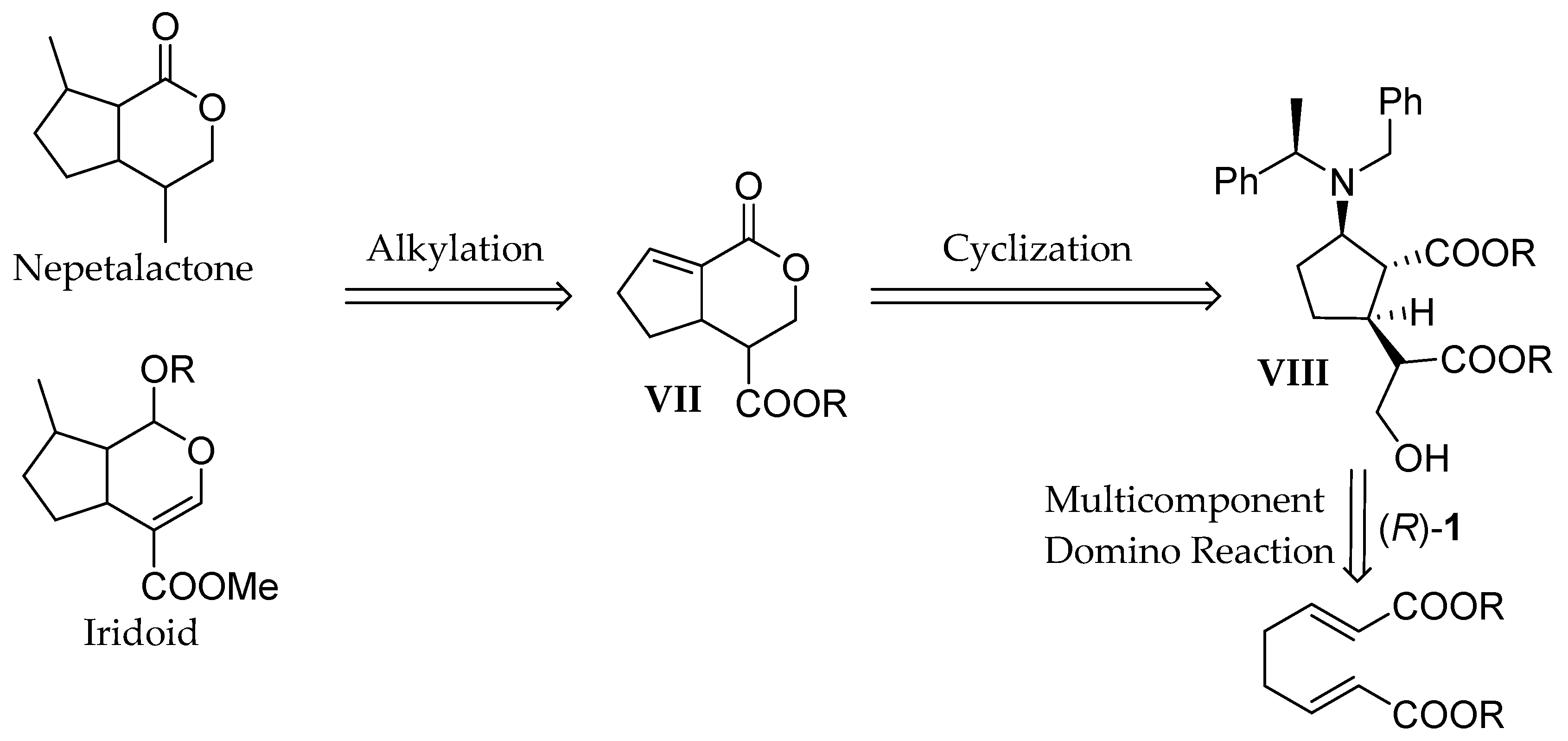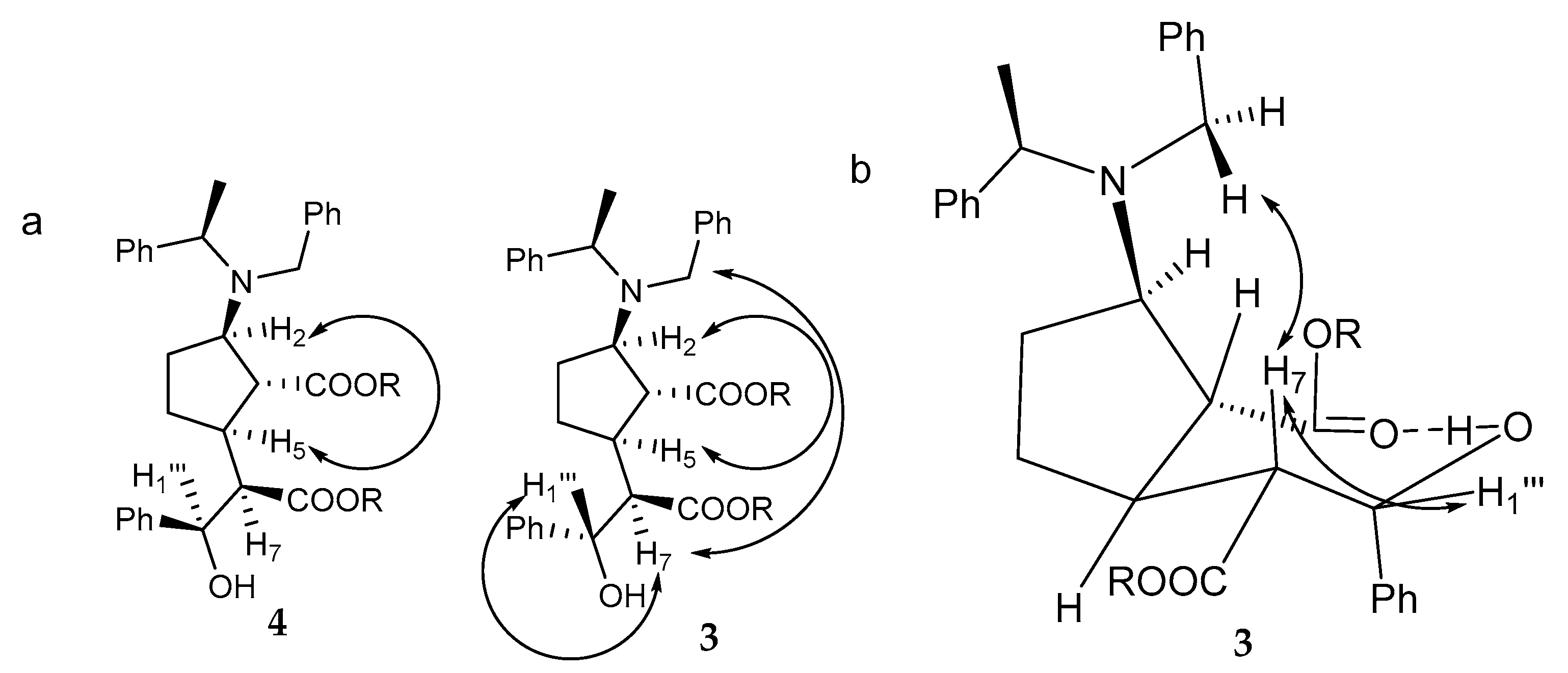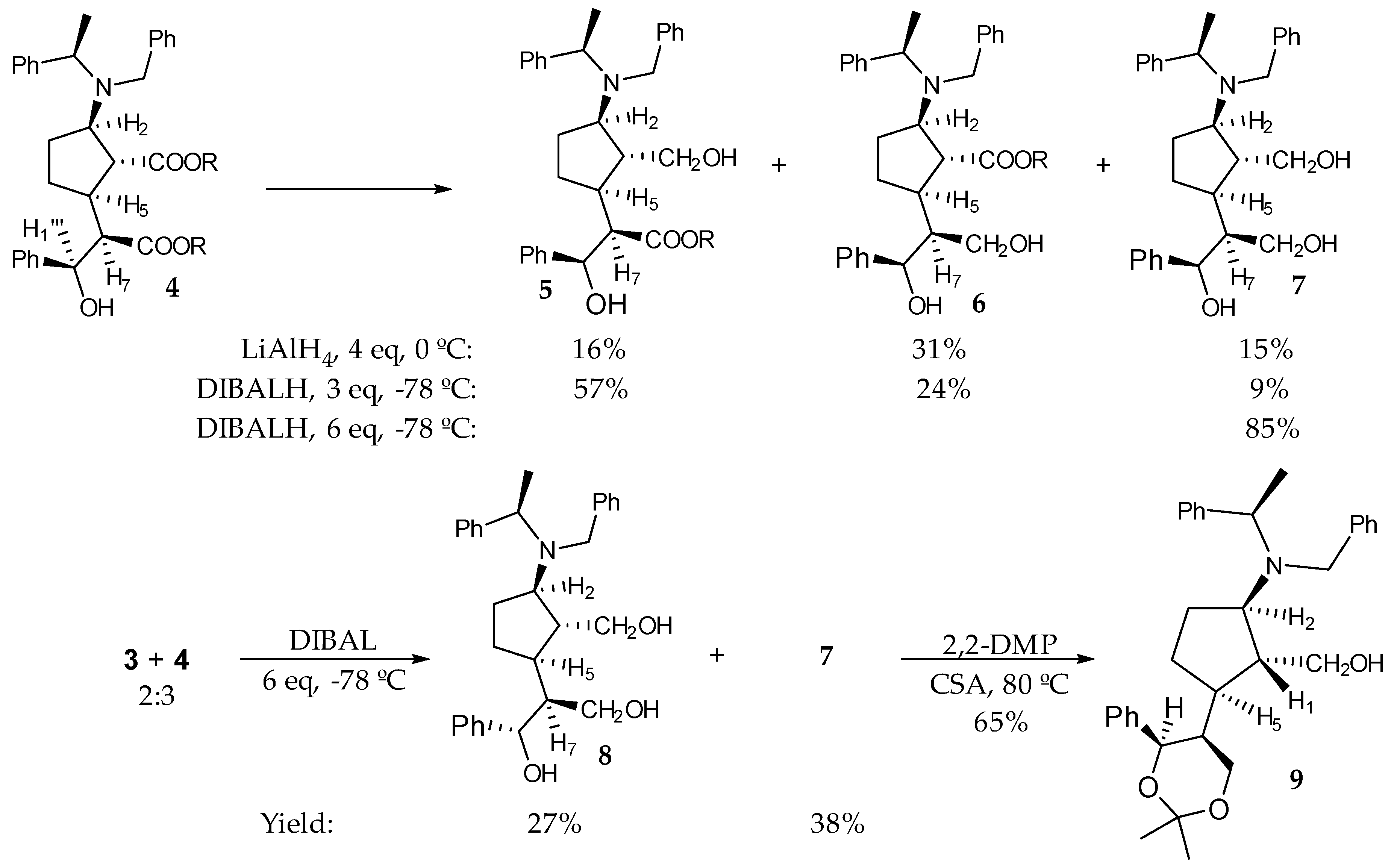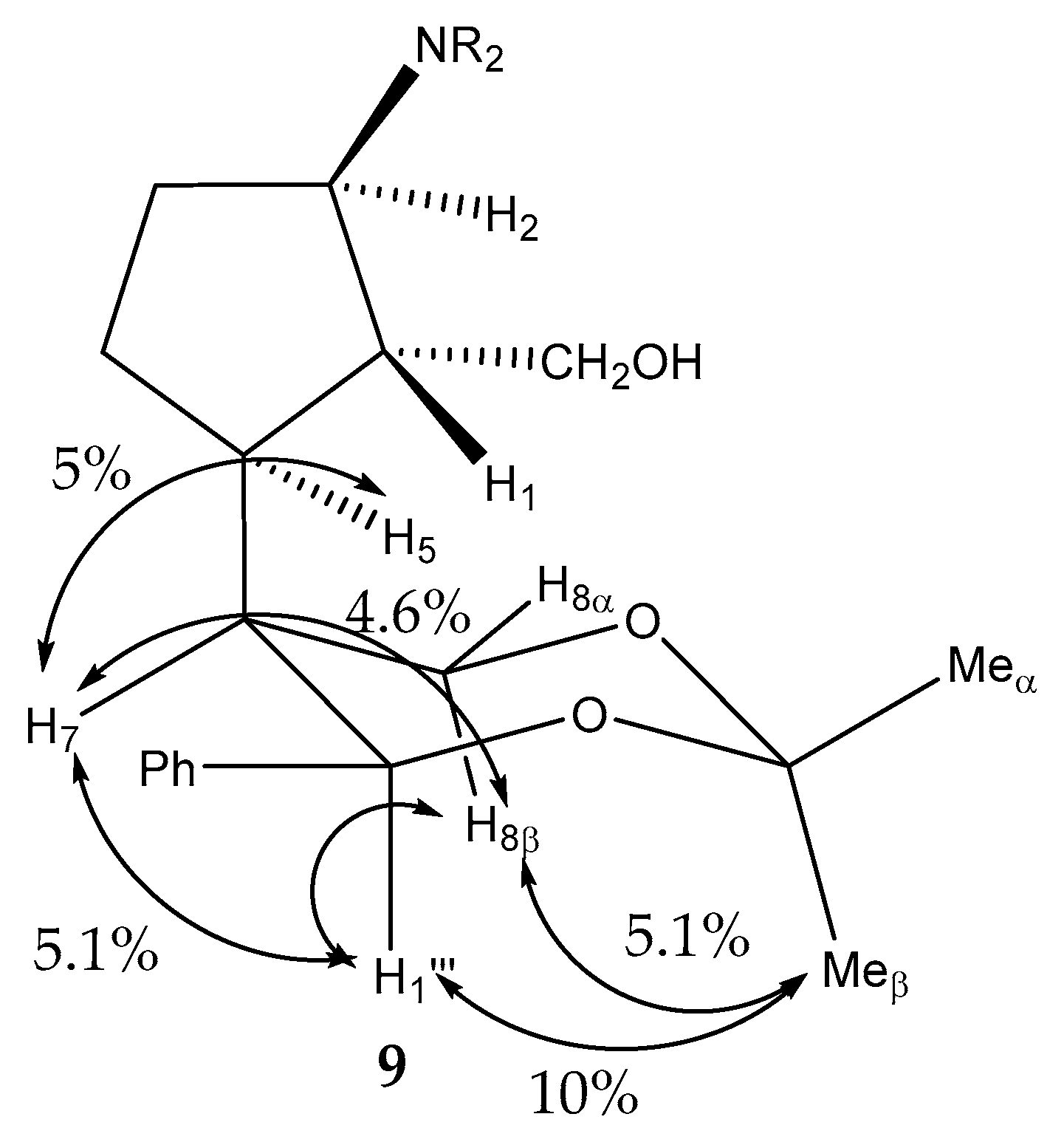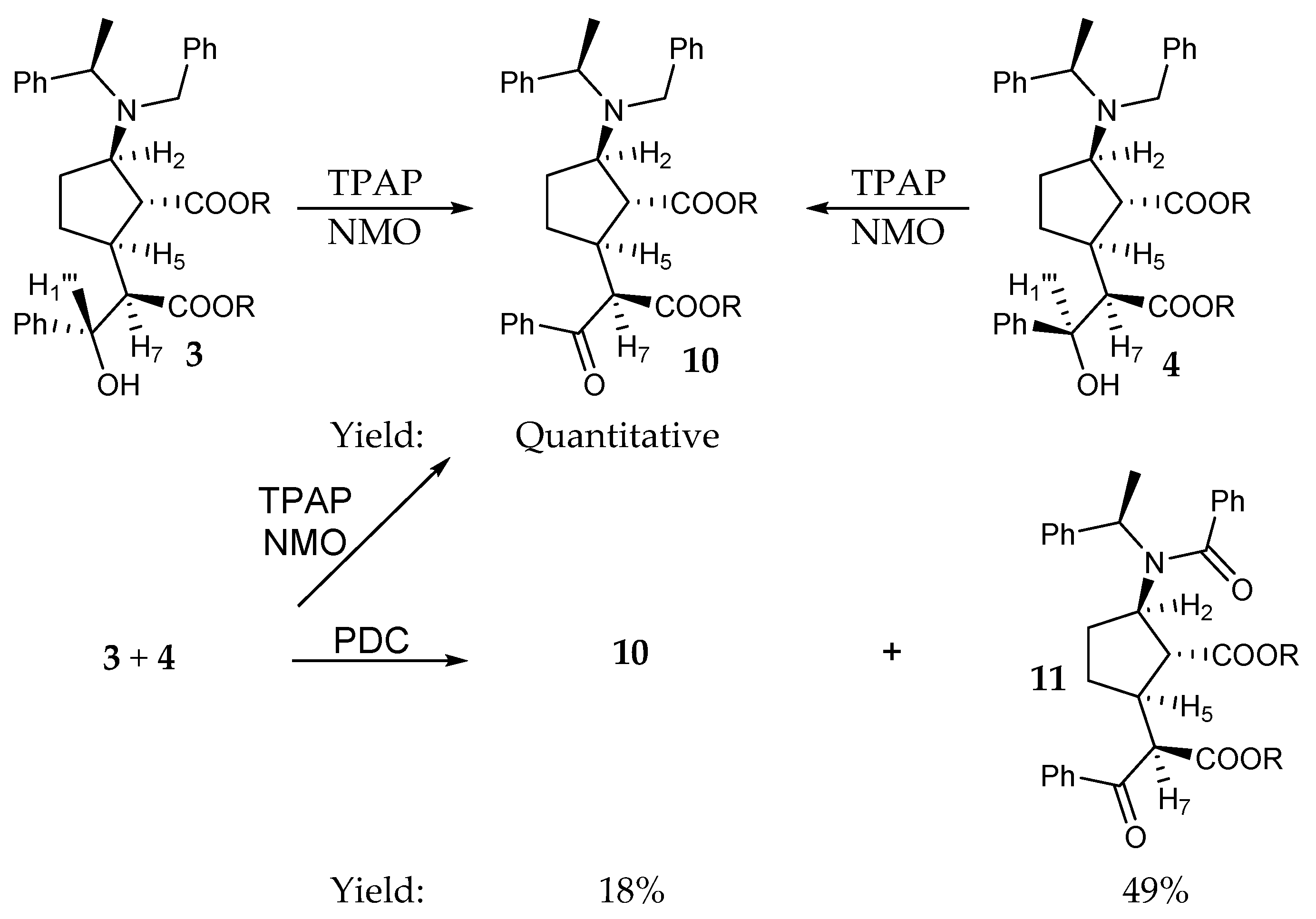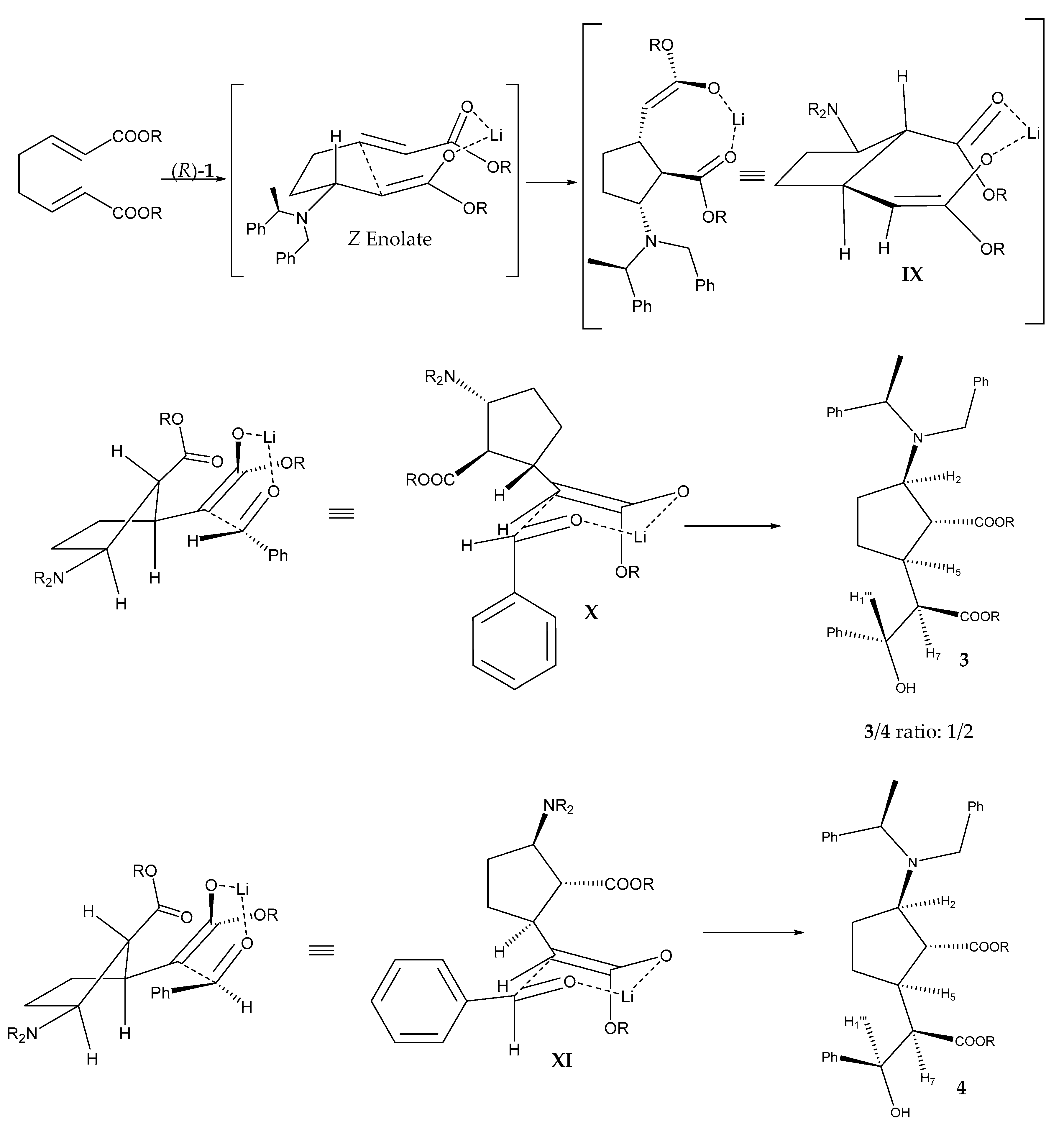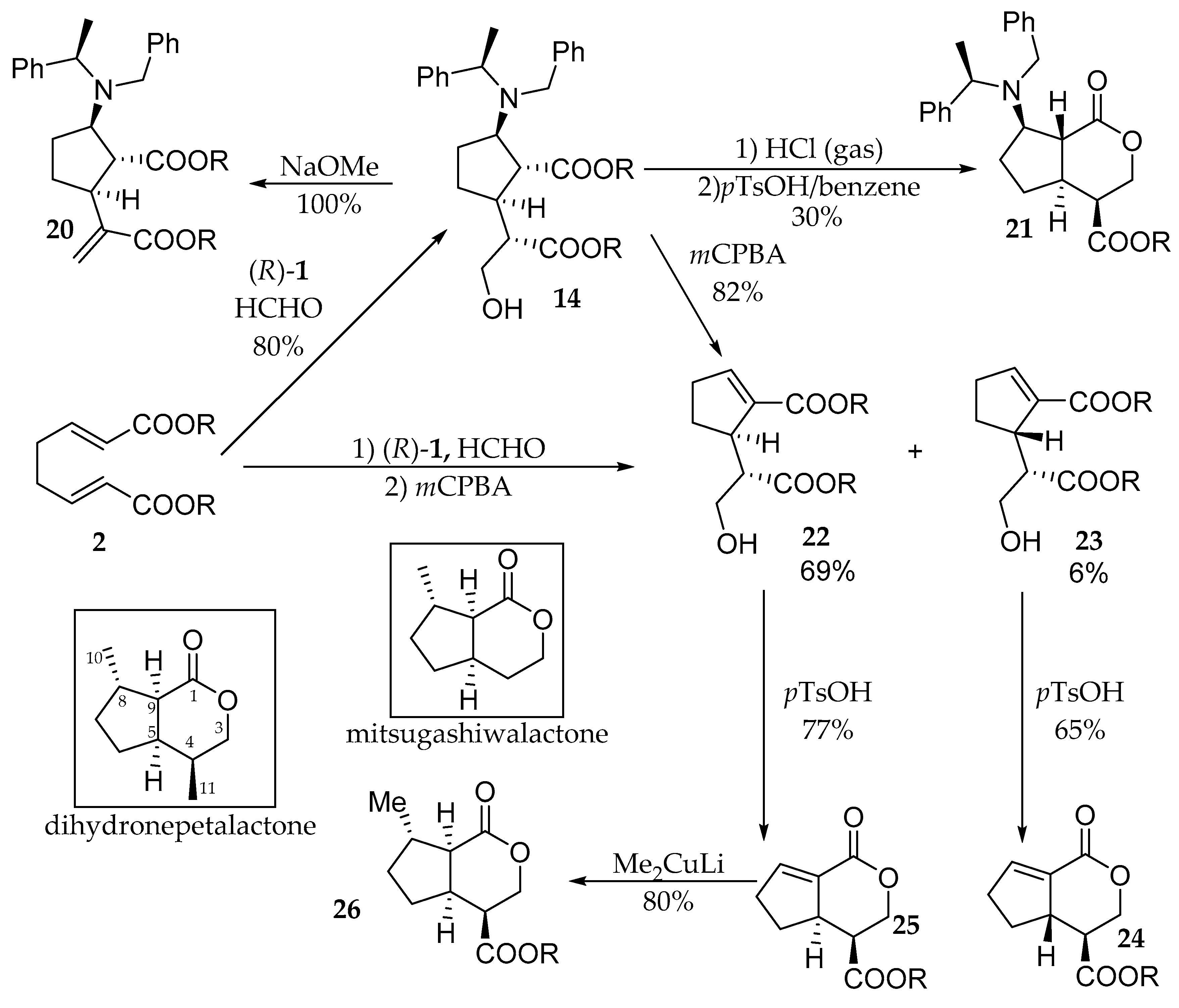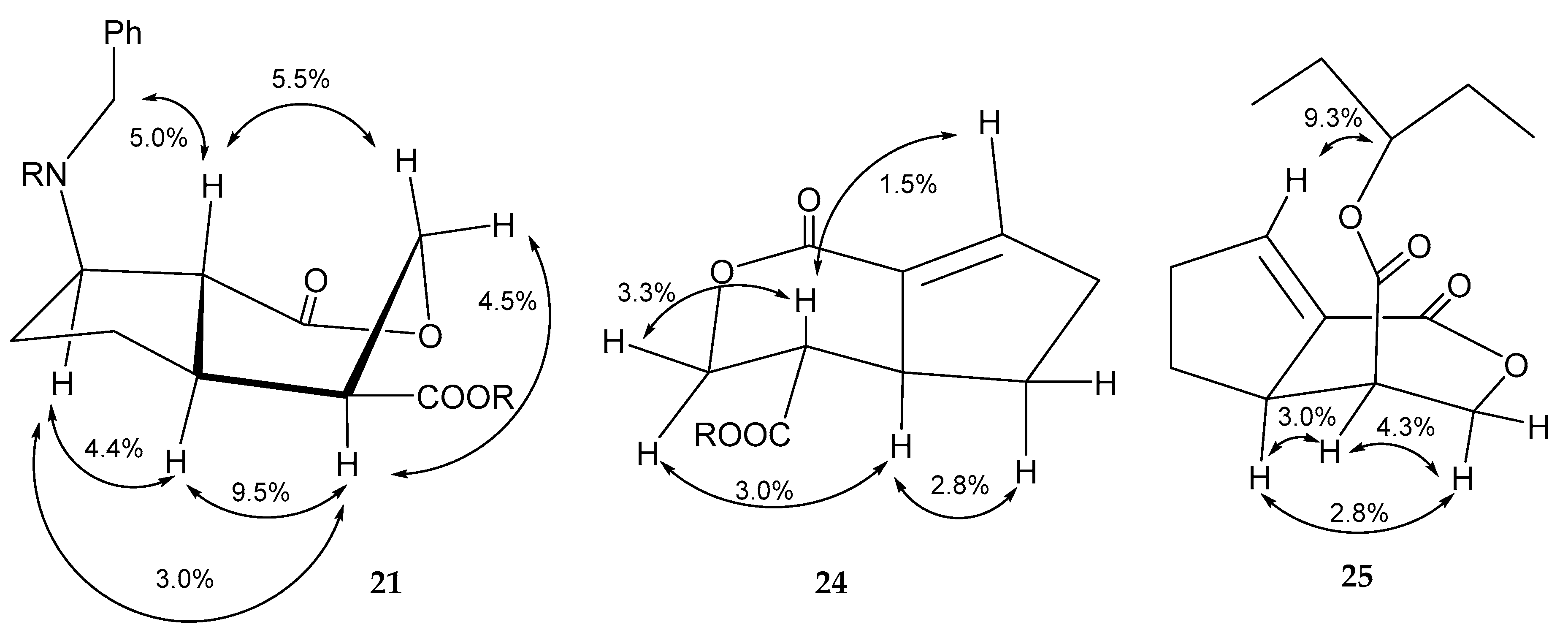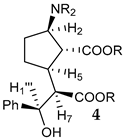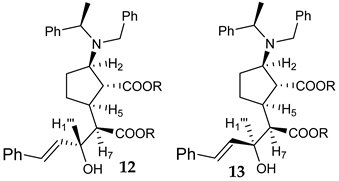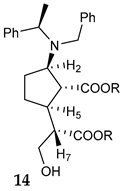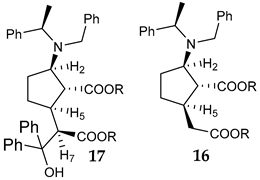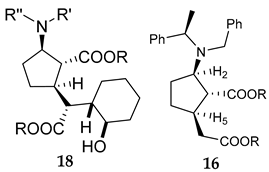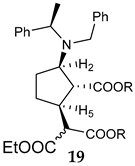4. Materials and Methods
4.1. General Information
Nuclear Magnetic Resonance: Both proton NMR (
1H-NMR) and carbon NMR (
13C-NMR), as well as 2D homo and heteronuclear experiments, were recorded in deuterated solvents, on spectrometers working on 200 MHz or 400 MHZ for proton and 50 MHz or 100 MHz for carbon, and are shown in the
Supplementary Materials. Data shown below is represented as follows: chemical shift, multiplicity, coupling constant, integral and assignment. -Mass Spectroscopy: Mass spectra was recorded using Atmospheric Pressure Chemical Ionization (APCI).
Rotatory Power: Rotatory power data was recorded using CHCl3 as solvent and sodium D line as polarized light ray.
Infrared Spectrometry: IR data was recorded using liquid IR spectrometer and NaCl crystal as supporting material.
Column chromatography: Silica column chromatography was performed using silica gel 60A (0.060-0.200 mm).
4.2. General Procedure for the Synthesis of Compounds 3–11
n-Buli in THF (1.6 M, 1.0 mL,1.60 mmol) was added under Ar atmosphere and at –78 °C to a solution of (R)-1, (357 mg, 1.69 mmol) in THF (7.0 mL). After 50 min of reaction, a solution of 2 (238 mg, 0.77 mmol) in THF (2.5 mL) was added. After 1 h, PhCHO (2.7 mL) was added and the reaction mixture was stirred until it reached room temperature. Then, a saturated solution of NH4Cl (6 mL) was added. The reaction mixture was dissolved in EtOAc and washed with H2O, brine and 10% aqueous Na2S2O3 solution. Then, the mixture was dried with Na2SO4 and, after being filtered, the solvent was evaporated. The resulting mixture (4.41 g) was chromatographed and the desired compounds eluted with hexane/EtOAc 95:5. Yield: 141 mg (23% yield) of 3 and 217 mg (45% yield) of 4.
Pentan-3-yl (1R,2R,5S)-2-(benzyl((R)-1-phenylethyl)amino)-5-((1S,2R)-1-hydroxy-3-oxo-3-(pentan-3-yloxy) -1-phenylpropan-2-yl)cyclopentane-1-carboxylate (3): [α]D26= +5.11(CHCl3, c= 0.89). IR (cm−1): 3495, 2969, 1723, 1460, 748, 698. H.R.M.S.: calcd for C40H53NO5: 627.3924; found: 627.3895. 1H-NMR δ (ppm) (400 MHz, CDCl3): 0.40 (3H, t, J = 7.3 Hz, CH(CH2CH3)2), 0.78 (3H, t, J = 7.3 Hz, CH(CH2CH3)2), 0.80 (3H, t, J = 7.3 Hz, CH(CH2CH3)2), 0.95 (3H, t, J = 7.3 Hz, CH(CH2CH3)2), 1.32 (3H, d, J = 7.0 Hz, H-2′), 1.55 (2H, m, H-4), 1.71 (2H, m, H-3), 2.62 (1H, m, H-1), 2.64 (1H, m, H-5), 2.71 (1H, m, H-7), 3.59 (1H, q, J = 7.6 Hz, H-2), 3.68 (1H, d, J = 14.6 Hz, H-1′’A), 3.72 (1H, d, J = 14.6 Hz, H-1′’B), 3.86 (1H, q, J = 7.0 Hz, H-1′), 3.92 (1H, d, J = 9.1 Hz, OH), 4.57 (2H, quintet, J = 6.1 Hz, CH(CH2CH3)2 × 2), 4.87 (1H, dd, J = 9.1 and 3.7 Hz, H-1′’’), 7.23-7.29 (15H, Ar). 13C-NMR δ (ppm) (CDCl3): 8.6 (CH3, CH(CH2CH3)2), 9.2 (CH3, CH(CH2CH3)2x2), 9.5 (CH3, CH(CH2CH3)2), 15.2, (CH3, C-2′), 25.3 (CH2, CH(CH2CH3)2x3), 25.6 (CH2, CH(CH2CH3)2), 27.3 (CH2, C-4), 28.8 (CH2, C-3), 41.5 (CH, C-5), 50.0 (CH2, C-1′’), 52.4 (CH, C-1), 55.1 (CH, C-7), 57.3 (CH, C-1′), 64.8 (CH, C-2), 72.2 (CH, C-1′’’), 76.5 (CH, CH(CH2CH3)2), 77.6 (CH, CH(CH2CH3)2), 125.6 - 128.6 (CHx10, Ar), 141.4 (C, Cipso), 142.4 (C, Cipso), 143.9 (C, Cipso), 174.5 (COOR, C-6), 182,4 (COOR, C-8).
Pentan-3-yl (1R,2R,5S)-2-(benzyl((R)-1-phenylethyl)amino)-5-((1R,2R)-1-hydroxy-3-oxo-3-(pentan-3-yl- oxy)-1-phenylpropan-2-yl)cyclopentane-1-carboxylate (4): [α]D26= +0.90 (CHCl3, c= 1.29). H.R.M.S.: calcd for C40H53NO5: 627.3924; found: 627.3864. IR (cm−1): 3495, 2969, 1723, 1495, 1169, 912, 748, 698. 1H-NMR δ (ppm) (400 MHz, CDCl3): 0.32 (3H, t, J = 7.5 Hz, CH(CH2CH3)2), 0.73 (3H, t, J = 7.5 Hz, CH(CH2CH3)2), 0.98 (3H, t, J = 7.5 Hz, CH(CH2CH3)2), 1.00 (3H, t, J = 7.5 Hz, CH(CH2CH3)2), 1.08 (2H, m, CH(CH2CH3)2), 1.28 (3H, d, J = 6.8 Hz, H-2′), 1.35 (2H, m, CH(CH2CH3)2), 1.55 (1H, m, H-4A), 1.64 (2H, m, CH(CH2CH3)2), 1.65 (2H, m, CH(CH2CH3)2), 1.75 (2H, m, H-3), 1.85 (1H, m, H-4B), 2.74 (2H, m, H-5), 2.87 (1H, dd, J = 10.0 and 3.8 Hz, H-7), 3.04 (1H, d, J = 10.0 Hz, OH), 3.23 (1H, dd, J = 10.1 and 9.9 Hz, H-1), 3.56 (1H, ddd, J = 9.9, 8.2 and 8.2 Hz, H-2), 3.67 (1H, d, J = 14.4 Hz, H-1′’A), 3.85 (1H, d, J = 14.4 Hz, H-1′’B), 3.90 (1H, q, J = 6.8 Hz, H-1′), 4.44 (1H, quintet, J = 6.0 Hz, CH(CH2CH3)2,), 4.64 (1H, dd, J = 10.0 and 3.5 Hz, H-1′’’), 4.67 (1H, quintet, J = 6.0 Hz, CH(CH2CH3)2), 7.1 - 7.6 (15H, Ar-H). 13C-NMR δ (ppm) (CDCl3): 8.6 (CH3, CH(CH2CH3)2), 9.0 (CH3, CH(CH2CH3)2), 9.2 (CH3, CH(CH2CH3)2) 9.4 (CH3, CH(CH2CH3)2), 15,1 (CH3, C-2′), 24.5 (CH2, CH(CH2CH3)2), 25.0 (CH2, CH(CH2CH3)2), 25.2 (CH2, CH(CH2CH3)2), 25.4 (CH2, CH(CH2CH3)2), 26.6 (CH2, C-3), 28.8 (CH2, C-4), 40.0 (CH, C-5), 49.9 (CH2, C-1′’), 50.0 (CH, C-1), 56.5 (CH2, C-7), 57.2 (CH, C- 1′), 65.1 (CH, C-2), 73.3 (CH, C-1′’’), 77.1 (CH, CH(CH2CH3)2), 77.4 (CH, CH(CH2CH3)2), 126.5 - 128.8 (CHx15, Ar), 141.3 (C, Cipso), 141.6 (C, Cipso), 144.1 (C, Cipso), 172.0 (COOR, C-8), 177.4 (COOR, C-6).
To a solution of 3 (121 mg, 0.193 mmol) in CH2Cl2 (3 mL) under an Ar atmosphere and at –78 °C, 1.5 M DIBALH (0.4 mL, 0.58 mmol) was added. After 2 h of reaction, H2O (1.5 mL) was added and the resulting mixture was washed in an Erlenmeyer flask with NaHCO3 and Na2SO4 (3 g of each) for 5 h. After being filtered, the solvent was evaporated and 101 mg of crude product were obtained. The desired compounds were subjected to chromatography eluting with hexane/EtOAc 9:1 to afford 59 mg of 5 (yield 57%), 25 mg of 6 (yield 24%) and 8 mg of 7 (yield 9%).
Pentan-3-yl (2R,3R)-2-((1S,2R,3R)-3-(benzyl((R)-1-phenylethyl)amino)-2-(hydroxymethyl)cyclopentyl)-3-hydroxy-3-phenylpropanoate (5): IR (cm−1): 3368, 2969, 1717, 1456, 1169, 1028, 750, 698. H.R.M.S.: calcd for C35H45NO4: 543.3349; found: 543.3398. 1H-NMR δ (ppm) (400 MHz, CDCl3): 0.37 (3H, t, J = 7.5 Hz, CH(CH2CH3)2), 0.78 (3H, t, J = 7.5 Hz, CH(CH2CH3)2), 1.13 (3H, m, CH(CH2CH3)2), 1.38 (3H, d, J = 6.8 Hz, H-2′), 1.35 (3H, m, CH(CH2CH3)2), 2.24 (1H, m, H-1), 2.24 (1H, m, H-5), 2.84 (1H, m, H-7), 2.84 (1H, m, H-2), 3.44 (1H, m, H-6A), 3.55 (1H, m, H-6B), 3.58 (1H, d, J = 14.4 Hz, H-1′’A), 3.91 (1H, d, J = 14.4 Hz, H-1′’B), 3.94 (1H, q, J = 6.8 Hz, H-1′), 4.70 (1H, quintet, J = 8 Hz, CH(CH2CH3)2), 4.96 (1H, d, J = 11.6 Hz, H-1′’’), 7.22-7.40 (15 H, Ar-H). 13C-NMR δ (ppm) (CDCl3): 8.6 (CH3, CH(CH2CH3)2), 9.7 (CH3, CH(CH2CH3)2), 12.4 (CH3, C-2′), 25.3 (CH2, CH(CH2CH3)2), 25.4 (CH2, CH(CH2CH3)2), 25.7 (CH2, C-3), 28.5 (CH2, C-4), 36.1 (CH, C-5), 45.1 (CH, C-1), 50.1 (CH2, C-1′’), 55.4 (CH, C-1′), 57.2 (CH, C-7), 60.7 (CH, C-2), 64.7 (CH, C-6), 73.3 (CH, C-1′’’), 76.8 (CH, CH(CH2CH3)2), 126.8 - 128.9 (CHx15, Ar), 140.8 (C, Cipso), 142.1 (C, Cipso), 144.0 (C, Cipso), 173.0 (COOR, C-8).
Pentan-3-yl (1R,2R,5R)-2-(benzyl((R)-1-phenylethyl)amino)-5-((1R,2S)-1,3-dihydroxy-1-phenyl- propan-2-yl)-cyclopentane-1-carboxylate (6): [α]D26 = -4.5 (CHCl3, c = 0.79). IR (cm−1): 3422, 2969, 1717, 1486, 1028, 750, 667. H.R.M.S.: calcd for C35H45NO4: 559.3662; found: 543.3293. 1H-NMR δ (ppm) (400 MHz, CDCl3): 0.83 (3H, t, J = 7.6 Hz, CH(CH2CH3)2), 0.89 (3H, t, J = 7.6 Hz, CH(CH2CH3)2), 1.26 (1H, m, H-4A), 1.31 (4H, m, CH(CH2CH3)2x2), 1.34 (3H, d, J = 6.8 Hz, H-2′), 1.65 (1H, m, H-3A), 1.75 (1H, m, H-3B), 1.80 (1H, m, H-4B), 1.99 (1H, m, H-7), 2.27 (1H, m, H-5), 2.73 (1H, t, J = 9.1 Hz, H-1), 3.51 (1H, d, J = 4.5 Hz, H-8A), 3.55 (1H, m, H-2), 3.69 (1H, d, J = 14.6, H-1′’A), 3.77 (1H, d, J = 14.6 Hz, H-1′’B), 3.82 (1H, m, H-8B), 3.90 (1H, q, J = 6.8 Hz, H-1′), 4.58 (1H, quintet, J = 5.9 Hz, CH(CH2CH3)2), 4.86 (1H, d, J = 6.5 Hz, H-1′’B), 7.2-7.6 (15H, Ar-H). 13C-NMR δ (ppm) (CDCl3): 9.0 (CH3, CH(CH2CH3)2), 9.2 (CH3, CH(CH2CH3)2), 15.1 (CH3, C-2′), 24.8 (CH2, CH(CH2CH3)2), 25.1 (CH2, CH(CH2CH3)2), 27.1 (CH2, C-3), 30.3 (CH2, C-4), 39.8 (CH, C-5), 50.0 (CH2, C-1′’), 50.6 (CH, C-7), 53.0 (CH, C-1), 58.0 (CH, C-1′), 63.4 (CH2, C-8), 65.1 (CH, C-2),75.6 (CH, C-1′’’), 77.0 (CH, CH(CH2CH3)2), 125.3 - 128.7 (CHx15, Ar), 141.5 (C, Cipso), 142.7 (C, Cipso), 143.9 (C, Cipso), 176.6 (COOR, C-6).
(1R,2S)-2-((1S,2R,3R)-3-(benzyl((R)-1-phenylethyl)amino)-2-(hydroxymethyl)cyclopentyl)-1-phenyl-propane-1,3-diol (7): IR (cm−1): 3339, 2940, 1495, 1028, 737, 700. H.R.M.S.: calcd for C30H37NO3: 459.2773; found: 459.2735 1H-NMR δ (ppm) (200 MHz, CDCl3): 1.26 (1H, m, H-7), 1.36 (3H, d, J = 6.8 Hz, H-2′), 1.46-1.87 (2H, m, H-3; 1H, m, H-4A, 1H, m, H-5) 1.92 (1H, m, H-4B), 1.95 (1H, m, H-1), 2.83 (1H, q, J = 8 Hz, H-2), 3.28 (1H, m, H-6A), 3.36 (1H, m, H-6B), 3.60 (2H, m, H-8), 3.62 (1H, d, J = 7.0 Hz, H-1′’B), 3.90 (1H, q, J = 6.8 Hz, H-1′), 3.94 (1H, d, J = 7.0 Hz, H -1′’A), 4.94 (1H, d, J = 5.8 Hz, H-1′’’), 7.21-7.38 (15 H, Ar-H). 13C-NMR δ (ppm) (CDCl3): 12.9 (CH3, C-2′), 25.9 (CH2, C-3), 29.0 (CH2, C-4), 36.1 (CH, C-5), 46.8 (CH, C-1), 50.3 (CH2, C-1′’), 56.5 (CH, C-1′), 50.7 (CH, C-7), 62.4 (CH, C-2), 62.8 (CH2, C-8), 66.0 (CH2, C-6), 75.3 (CH, C-1′’’), 126.5 – 129.3 (CHx15, Ar), 140.7 (C, Cipso), 143.4 (C, Cipso), 143.6 (C, Cipso).
Also, to a solution of 3 (147 mg, 0.235 mmol) in dry ether (5 mL) at 0 °C, LiAlH4 (24 mg) was added and, after 45 min of stirring, dry ether saturated with water (1 mL) was added. The reaction mixture was filtered through Celite-silica and washed with ether and CHCl3. The solvent was evaporated and 101 mg of crude product were obtained and chromatographed. 20 mg of 5 (yield 16%), 39 mg of 6 (yield 31%) and 16 mg of 7 (yield 15%).
To a solution of 3 + 4 (2:3 ratio) (86 mg, 0.137 mmol) in DCM (3 mL), 1.5 M DIBALH (1.12 mL, 1.680 mmol) was added at –78 °C under an Ar atmosphere. After 1 h, the reaction flask was allowed to reach room temperature and H2O (1.5 mL) was added. Then, the reaction mixture was placed in an Erlenmeyer flask with ether, NaHCO3 (3 g) and Na2SO4 (3 g) and the resulting mixture left stirring for 5 h. Then, it was chromatographed and the desired products were eluted with hexane/EtOAc 8:2 to give 26 mg of 7 (yield 38%) and 18 mg of 8 (yield 27%).
(1S,2S)-2-((1S,2R,3R)-3-(benzyl((R)-1-phenylethyl)amino)-2-(hydroxymethyl)cyclopentyl)-1-phenyl- propane-1,3-diol (8): I.R. (cm−1): 3341, 2930, 1495, 1059, 750, 700. 1H-NMR δ (ppm) (400 MHz, CDCl3): 1.25 (1H, H-7), 1.39 (3H, d, J = 6.9 Hz, H-2′), 1.44 (1H, m, H-5), 1.67 (1H, m, H-4A), 1.74 (2H, m, H-3), 1.77 (1H, m, H-5), 1.86 (1H, m, H-4B), 2.11 (1H, m, H-1), 2.83 (1H, q, J = 8 Hz, H-2), 3.33 (2H, m, H-6), 3.63 (1H, d, J = 13.8 Hz, H-1′’A), 3.64 (2H, m, H-8), 3.78 (1H, d, J = 13.8 Hz, H-1′’B), 3.92 (1H, q, J = 6.9 Hz, H-1′), 5.00 (1H, d, J = 3.1 Hz, H-1′’’), 7.21-7.40 (15 H, Ar-H). 13C-NMR δ (ppm) (CDCl3): 13.2 (CH3, C-2′), 25.9 (CH2, C-3), 28.8 (CH2, C-4), 36.5 (CH, C-5), 47.3 (CH, C-1), 50.7 (CH2, C-1′’), 56.5 (CH, C-1′), 50.1 (CH, C-7), 62.3 (CH, C-2), 60.9 (CH2, C-8), 66.0 (CH2, C-6), 76.5 (CH, C-1′’’), 126.6 –129.1 (CHx15, Ar), 140.8 (C, Cipso), 143.9 (C, Cipso), 144.8 (C, Cipso).
To a solution of 7 (22 mg, 0.048 mmol) in acetone (5 mL), a catalytic amount of camphorsulfonic acid (CSA) and 2,2-DMP (5 mL) were added. The reaction was heated up to reflux for 7 h. The reaction mixture was solved in ether and washed with NaHCO3 saturated solution, brine and H2O. The resulting solution was dried with Na2SO4 and, after being filtered, 42 mg of crude product were obtained and chromatographed. The desired compound was eluted with hexane/EtOAc 95:5, and 12 mg of 9 were obtained (yield 65%).
((1R,2R,5S)-2-(benzyl((R)-1-phenylethyl)amino)-5-((4R,5S)-2,2-dimethyl-4-phenyl-1,3-dioxan-5-yl)cyclo- pentyl)methanol (9): IR (cm−1): 3332, 2938, 1451, 1200, 739, 700. H.R.M.S.: calcd for C33H41NO3: 499.3086; found: 499.3044. 1H-NMR δ (ppm) (400 MHz, CDCl3): 0.22 (1H, m, H-4A), 0.88 (1H, m, H- 5), 1.17 (1H, m, H-4B), 1.27 (3H, d, J = 6.8 Hz, H-2′), 1.28-1.40 (1H, m, H-3A), 1.47 (3H, s, (CH3)2), 1.49 (3H, s, (CH3)2), 1.57 (1H, m, H-7), 1.68 (1H, m, H-3B), 1.68 (1H, m, H-1), 2.71 (1H, q, J = 8, H-2), 3.08 (1H, dd, J = 10.5 and 6.5 Hz, H-6A), 3.47 (1H, d, J = 13.5 Hz, H-1′’A), 3.62 (1H, dd, J = 10.5 and 2.4 Hz, H-6B), 3.69 (1H, d, J = 13.5 Hz, H-1′’B), 3.85 (1H, q, J = 6.8 Hz, H-1′), 3.93 (1H, d, J = 12.1 Hz, H-8A), 4.17 (1H, dd, J = 12.1 and 2.9 Hz, H-8B), 5.22 (1H, d, J = 2 Hz, H-1′’’), 7.1-7.6 (15H, Ar-H). 13C-NMR δ (ppm) (CDCl3): 12.6 (CH3, C-2′), 18.9 (CH, (CH3)2), 25.9 (CH2, C-3), 29.5 (CH, (CH3)2), 30.1 (CH2, C-4), 35.2 (CH, C-5), 43.2 (CH, C-1), 46.6 (CH, C-7), 49.6 (CH, C-1′’), 56.0 (CH, C-1′), 62.5 (CH, C-2), 64.2 (CH2, C-8), 66.0 (CH2, C-6), 73.4 (CH, C-1′’’), 99.0 (CH, (CH3)2), 125.6 –129.2 (CHx15, Ar), 140.0 (C, Cipso), 141.0 (C, Cipso), 144.2 (C, Cipso),143.4 (C, Cipso).
To a solution of 4 (25 mg, 0.04 mmol) in CH2Cl2 (3.5 mL), molecular sieves (11 mg) and TPAP (1 mg, 0.004 mmol) were added. After 3 h of stirring, the resulting mixture was filtered through Celite-silica with CH2Cl2 and, after solvent evaporation, 23 mg of 10 (yield 91%) were obtained.
Pentan-3-yl (1R,2R,5S)-2-(benzyl((R)-1-phenylethyl)amino)-5-((R)-1,3-dioxo-1-(pentan-3-yloxy)-3-phenyl-propan-2-yl)cyclopentane-1-carboxylate (10): H.R.M.S.: calcd for C40H51NO5: 626.3767; found: 626.3903. 1H-NMR δ (ppm) (400 MHz, CDCl3): 0.70 (3H, t, J = 7.3 Hz, CH(CH2CH3)2), 0.77 (3H, t, J = 7.3 Hz, CH(CH2CH3)2), 0.84 (3H, t, J = 7.3 Hz, CH(CH2CH3)2), 0.92 (3H, t, J = 7.3 Hz, CH(CH2CH3)2), 1.25 (2H, m, CH(CH2CH3)2), 1.31 (3H, d, J = 6.9 Hz, H-2′) 1.41 (2H, m, CH(CH2CH3)2), 1.45 (2H, m, CH(CH2CH3)2), 1.52 (1H, m, H-4A), 1.64 (2H, m, CH(CH2CH3)2), 1.75 (2H, m, H-3), 1.85 (1H, m, H-4B), 2.77 (1H, m, H-5), 2.92 (1H, dd, J = 8.6 and 7.3 Hz, H-1), 3.62 (1H, m, H-2), 3.89 (1H, q, J = 6.9 Hz, H-1′), 4.3 (1H, d, J = 10 Hz, H-7), 3.90 (1H, d, J = 14.5 Hz, H-1′’A), 3.93 (1H, d, J = 14.5 Hz H-1′’B), 4.59 (1H, quintet, J = 5.7 Hz, CH(CH2CH3)2), 4.69 (1H, quintet, J = 5.7 Hz, CH(CH2CH3)2), 7.1-7.6 (13H, m, Ar-H), 7.9 (2H, d, J = 7.3 Hz). 13C-NMR δ (ppm) (CDCl3): 9.5 (CH3, CH(CH2CH3)2x3), 9.6 (CH3, CH(CH2CH3)2) 15.8 (CH3, C-2′), 25.5 (CH2, CH(CH2CH3)2), 25.6 (CH2, CH(CH2CH3)2x2), 26.1 (CH2, CH(CH2CH3)2), 27.7 (CH2, C-3), 28.8 (CH2, C-4), 41.5 (CH, C-5), 52.6 (CH, C-1), 50.3 (CH2, C-1′’), 57.0 (CH2, C-7), 57.8 (CH, C-1′), 65.3 (CH, C-2), 77.1 (CH, CH(CH2CH3)2), 78.5 (CH, CH(CH2CH3)2), 126.7 - 128.8 (CHx15, Ar), 137.8 (C, Cipso), 141.9 (C, Cipso), 144.7 (C, Cipso), 169.2 (COOR, C-8), 175.1 (COOR, C-6), 194.1 (C, C-1′’’).
To a solution of 4 + 3 (29 mg, 0.045 mmol) in CH2Cl2 (3 mL) PDC (26 mg, 0.0687 mmol) was added. After 24 h, saturated NH4Cl solution (3 mL) was added and the resulting mixture was filtered, dissolved in EtOAc and washed with H2O and brine. After drying over Na2SO4, filteration and solvent evaporated, the resulting 27 mg were chromatographed and the desired compounds eluted with hexane/EtOAc 95:5 to afford 5 mg of 10 (yield 18%) and 13 mg of 11 (yield 49%).
Pentan-3-yl (1R,2S,5R)-2-((R)-1,3-dioxo-1-(pentan-3-yloxy)-3-phenylpropan-2-yl)-5-(N-((R)-1-phenyl-ethyl)benzamido)cyclopentane-1-carboxylate (11) IR (cm−1): 2969, 1732, 1688, 1456, 1219, 1105, 702. 1H-NMR δ (ppm) (400 MHz, CDCl3): 0.60-0.93 (12H, m, CH(CH2CH3)2), 1.26 (3H, d, J = 7.1 Hz, H-2′), 1.30-1.62 (8H, m, CH(CH2CH3)2), 1.52 –1.99 (4H, m, H-3 and H-4), 2.48 (1H, dd, J = 8.6 and 7.3 Hz, H-1), 3.15 (1H, m, H-5), 3.17 (1H, m, H-7), 3.89 (1H, q, J = 7.1 Hz, H-1′), 4.45 (1H, dd, J = 13.3 and 7.3 Hz, H-2), 4.71 (2H, m, CH(CH2CH3)2x2), 7.1-7.6 (11H, m, Ar-H), 7.9 (4H, m, Ar-H). 13C-NMR δ (ppm) (CDCl3): 9.4 (CH3, CH(CH2CH3)2) 9.5 (CH3, CH(CH2CH3)2x2), 9.7 (CH3, CH(CH2CH3)2), 22.2 (CH3, C-2′), 25.7 (CH2, CH(CH2CH3)2), 26.0 (CH2, CH(CH2CH3)2), 26.1 (CH2, CH(CH2CH3)2), 26.2 (CH2, CH(CH2CH3)2), 29.5 (CH2, C-3), 31.1 (CH2, C-4), 43.3 (CH, C-5), 53.1 (CH, C-1), 57.9 (CH2, C-7), 58.1 (CH, C-1′), 61.5 (CH, C-2), 78.1 (CH, CH(CH2CH3)2), 78.5 (CH, CH(CH2CH3)2), 128.8–129.5 (CHx15, Ar), 133.7 (C, Cipso), 133.8 (C, Cipso), 136.6 (C, Cipso), 168.9 (COOR, C-8), 173.7 (COOR, C-6), 194.7 (C, C-1′’’), 195.3 (C, C-1′’).
4.3. General Tandem Domino Michael Addition Procedure: Compounds 12–20
To a solution of (R)-1 (2.3 equivalents) in THF at –78 °C under Ar atmosphere, 1.6 M n-BuLi (2.2 equivalents) was added. After 50 min of reaction, 2 (1 equivalent) was added and, after 1 h of reaction, an electrophile (1.5 equivalents) in THF was added. Then, after 3 h, the reaction was quenched with NH4Cl. The resulting reaction mixture was dissolved with EtOAc and washed with 10% aqueous citric acid solution, H2O and brine. After being dried over Na2SO4 and filtered, the solvent was evaporated and the reaction mixture was chromatographed.
When using benzaldehyde as electrophile, 1.34 g of reaction mixture were obtained and chromatographed to give 63 mg (yield 30%) of 12 and 57 mg (yield 27%) of 13.
Pentan-3-yl (1R,2R,5S)-2-(benzyl((R)-1-phenylethyl)amino)-5-((2R,3R,E)-3-hydroxy-1-oxo-1-(pentan-3-yl-oxy)-5-phenylpent-4-en-2-yl)cyclopentane-1-carboxylate (12): IR (cm−1): 3503, 2967, 1724, 1458, 1177, 1105, 698. H.R.M.S.: calcd for C42H55NO5: 653.4080; found: 653.4150. 1H-NMR δ (ppm) (200 MHz, CDCl3): 0.60-0.96 (9H, m, CH(CH2CH3)2), 1.12 (3H, m, CH(CH2CH3)2), 1.32 (3H, d, J = 6.8 Hz, H-2′), 1.35-1.58 (8H, m, CH(CH2CH3)2), 1.55-1.90 (4H, m, H-3 and H-4), 2.53 (1H, d, J = 7.5, H-7), 2.61 (1H, m, H-5), 2.82 (1H, t, J = 6Hz, H-1), 3.35 (1H, d, J = 8.4 Hz, OH), 3.63 (1H, d, J = 4.2 Hz, H-1′’A), 3.77 (1H, ddd, H-2), 3.85 (1H, q, J = 6.8 Hz, H-1′), 3.87 (1H, d, J = 4.2 Hz, H-1′’B), 4.42 (1H, m, H-1′’’), 4.55 (1H, q, J = 6.0, CH(CH2CH3)2), 4.71 (1H, quintet, J = 6.0 Hz, CH(CH2CH3)2), 6.18 (1H, dd, J = 14.2 and 5.2 Hz, H-2′’’), 6.60 (1H, d, J = 17.4 Hz, H-3′’’), 7.1-7.6 (10H, Ar-H). 13C-NMR δ (ppm) (CDCl3): 9.4 (CH3, CH(CH2CH3)2x2), 9.8 (CH3, CH(CH2CH3)2x2), 15.6 (CH3, C-2′), 25.5 (CH2, CH(CH2CH3)2), 25.9 (CH2, CH(CH2CH3)2), 26.1 (CH2, CH(CH2CH3)2), 27.5 (CH2, CH(CH2CH3)2), 28.8 (CH2, C-3), 29.1 (CH2, C-4), 41.5 (CH, C-5), 50.3 (CH2, C-1′’), 52.5 (CH, C-1), 53.8 (CH2, C-7), 57.5 (CH, C-1′), 65.1 (CH, C-2), 71.1 (CH, C-1′’’), 76.8 (CH, CH(CH2CH3)2), 77.1 (CH, CH(CH2CH3)2), 126.6-128.8 (CHx15, Ar), 130.4 (CH, Ph-CH=CH-), 130.9 (CH, Ph-CH=CH-), 136.7 (C, Cipso), 141.6 (C, Cipso), 144.3 (C, Cipso), 174.2 (COOR, C-8), 174.9 (COOR, C-6).
Pentan-3-yl (1R,2R,5S)-2-(benzyl((R)-1-phenylethyl)amino)-5-((2R,3S,E)-3-hydroxy-1-oxo-1-(pentan-3-yl-oxy)-5-phenylpent-4-en-2-yl)cyclopentane-1-carboxylate (13): IR (cm−1): 3510, 2969, 1719, 1458, 1105, 698. 1H-NMR δ (ppm) (200 MHz, CDCl3): 0.63 (3H, m, CH(CH2CH3)2), 0.73-1.01 (9H, m, CH(CH2CH3)2), 1.27 (3H, d, J = 6.8 Hz, H-2′), 1.38-1.95 (8H, m, CH(CH2CH3)2; 2H, m, H-3; 2H, m, H-4), 2.60 (1H, m, H-5), 2.63 (1H, d, J = 8 Hz, H-7), 2.93 (1H, d, J = 4.5 Hz, OH), 3.10 (1H, t, J = 6Hz, H-1), 3.63 (1H, d, J = 4.2 Hz, H-1′’A), 3.77 (1H, m, H-2), 3.85 (1H, q, J = 6.8 Hz, H-1′), 3.87 (1H, d, J = 6.8 Hz, H-1′’B), 4.31 (1H, m, H-1′’’), 4.64 (2H, m, CH(CH2CH3)2x2), 6.18 (1H, dd, H-2′’’), 6.53 (1H, d, H-3′’’), 7.1-7.6 (10H, Ar-H).
When using formaldehyde as electrophile, 155 mg of crude product were obtained and chromatographed to give after elution with hexane/EtOAc 95:5 140 mg (yield 80%) of 14.
Pentan-3-yl (1R,2R,5S)-2-(benzyl((R)-1-phenylethyl)amino)-5-((S)-3-hydroxy-1-oxo-1-(pentan-3-yloxy)-propan-2-yl)cyclopentane-1-carboxylate (14): IR (cm−1): 3488, 2969, 1726, 1456, 1105, 748, 700. H.R.M.S.: calcd for C34H49NO5: 551.3611; found: 551.3573. 1H-NMR δ (ppm) (400 MHz, CDCl3): 0.83 (9H, m, CH(CH2CH3)2), 0.96 (3H, t, J = 7.5 Hz, CH(CH2CH3)2), 1.30 (3H, d, J = 6.8 Hz, H-2′), 1.4-1.6 (8H, m, CH(CH2CH3)2), 1.63 (2H, m, H-3), 1.72 (2H, m, H-4), 2.46 (1H, m, H-5), 2.62 (1H, d, J = 7.5, H-7), 2.76 (1H, t, J = 9.5 Hz, H-1), 3.60 (1H, m, H-1′’’A), 3.64 (1H, m, H-2), 3.65 (1H, m, H-1′’’B),3.71 (1H, d, J = 11.1 Hz, H-1′’A), 3.64 (1H, m, H-2), 3.80 (1H, d, J = 11.1 Hz, H-1′’B), 3.85 (1H, q, J = 6.8 Hz, H-1′), 4.61 (1H, quintet, J = 6.0, CH(CH2CH3)2), 4.75 (1H, quintet, J =6 Hz, CH(CH2CH3)2), 7.1-7.6 (10H, Ar-H). 13C-NMR δ (ppm) (CDCl3): 9.4 (CH3, CH(CH2CH3)2), 9.5 (CH3, CH(CH2CH3)2), 9.7 (CH3, CH(CH2CH3)2), 9.8 (CH3, CH(CH2CH3)2), 15.4 (CH3, C-2′), 25.4 (CH2, CH(CH2CH3)2x2), 25.6 (CH2, C-3), 26.4 (CH2, CH(CH2CH3)2), 26.6 (CH2, CH(CH2CH3)2), 41.1 (CH, C-5), 49.5 (CH, C-1), 50.2 (CH2, C-1′’), 51.8 (CH, C-1′), 57.8 (CH, C-7), 61.1 (CH2, C-1′’’), 64.5 (CH2, C-2), 77.1 (CH, CH(CH2CH3)2), 77.6 (CH, CH(CH2CH3)2), 126.4 –128 (CHx10, Ar), 141.6 (C, Cipso), 144.3 (C, Cipso), 173.9 (COOR, C–8), 175.3 (COOR, C–6).
When using acetone as electrophile, 160 mg were obtained and chromatographed to obtain 60 mg (yield 27%) of 15 and 100 mg (yield 25%) of 16.
Pentan-3-yl (1R,2R,5S)-2-(benzyl((R)-1-phenylethyl)amino)-5-((R)-3-hydroxy-3-methyl-1-oxo-1-(pentan-3-yloxy)butan-2-yl)cyclopentane-1-carboxylate (15): 1H-NMR δ (ppm) (200 MHz, CDCl3): 0.8-0.9 (12H, m, CH(CH2CH3)2), 1.17 (3H, s, CH3), 1.18 (3H, s, CH3), 1.26 (3H, d, J = 6.8 Hz, H-2′), 1.41-1.91 (8H, m, CH(CH2CH3)2); 2H, m, H-3; 2H, m, H-4), 2.38 (1H, d, J = 5.2 Hz, H-7), 2.63 (1H, m, H-5), 2.83 (1H, t, J = 8.8 Hz, H-1), 3.41-3.92 (1H, m, H-1′; 2H, m, H-1′’’; 1H, m, H-2), 4.50 (1H, quintet, J = 6 Hz, CH(CH2CH3)2), 4.75 (1H, quintet, J = 6 Hz, CH(CH2CH3)2), 7.1-7.6 (10H, Ar-H). 13C-NMR δ (ppm) (CDCl3): 9.3 (CH3, CH(CH2CH3)2x2), 9.8 (CH3, CH(CH2CH3)2x2), 14.7 (CH3, C-2′), 24.7 (CH2, CH(CH2CH3)2x2), 26.0 (CH2, CH(CH2CH3)2), 26.5 (CH2, C-3), 26.6 (CH2, CH(CH2CH3)2), 30.3 (CH2, C-4), 39.0 (CH, C-5), 49.5 (CH, C-1), 50.1 (CH2, C-1′’), 52.1 (CH, C-1), 57.8 (CH, C-7), 61.1 (CH2, C-1′’’), 64.5 (CH2, C-2), 77.1 (CH, CH(CH2CH3)2), 77.6 (CH, CH(CH2CH3)2), 126.4 –128 (CHx10, Ar), 141.6 (C, Cipso), 144.3 (C, Cipso), 173.9 (COOR, C –8), 175.3 (COOR, C–6).
Pentan-3-yl (1R,2R,5R)-2-(benzyl((R)-1-phenylethyl)amino)-5-(2-oxo-2-(pentan-3-yloxy)ethyl)cyclopentane-1-carboxylate (16): [α]D26 = -30.1 (CHCl3, c = 1.55). IR (cm−1): 2969, 1728, 1454, 1170, 974, 698. 1H-NMR δ (ppm) (400 MHz, CDCl3): 0.78 (3H, t, J = 7.5 Hz, CH(CH2CH3)2), 0.85 (6H, t, J = 7.5, CH(CH2CH3)2x2), 0.94 (3H, t, J = 7.5 Hz, CH(CH2CH3)2), 1.28 (3H, d, J = 6.8, H-2′), 1.40 - 1.75 (10H, m, CH2), 1.75 - 1.85 (2H, m), 2.17 (1H, dd, J = 14.8 and 9.6 Hz, H-7A), 2.39 (1H, m, H-5), 2.50 (1H, dd, J = 9.6 and 3.6 Hz, H-7B), 2.53 (1H, dd, J = 10.0 and 10.0 Hz, H-1), 3.71 (1H, m, H-2), 3.75 (2H, m, H-1′’), 3.86 (1H, q, J = 6.8 Hz, H-1′), 4.58 (1H, quintet, J = 7.5 Hz, CH(CH2CH3)2), 4.71 (1H, quintet, J = 7.5 Hz, CH(CH2CH3)2), 7.1-7.5 (10, m, Ar-H). 13C-NMR δ (ppm) (CDCl3): 9.4 (CH3, CH(CH2CH3)2), 9.5 (CH3, CH(CH2CH3)2x3), 15.5 (CH3, C-2′), 25.8 (CH2, C-3), 26.4 (CH2, CH(CH2CH3)2x3), 26.7 (CH2, CH(CH2CH3)2), 31.0 (CH2, C-4), 39.0 (CH2, C-7), 39.1 (CH, C-5), 50.0 (CH2, C-1′’), 55.3 (CH, C-1), 58.0 (CH, C-1′), 63.7 (CH, C-2), 76.6 (CH, CH(CH2CH3)2x2), 126.5 - 128.5 (CHx10, Ar), 141.6 (C, Cipso), 144.3 (C, Cipso), 171.7 (COOR, C-8), 174.3 (COOR, C-6).
When using diphenylketone as electrophile, 483 mg of crude product were obtained and chromatographed. The desired compounds were eluted with hexane/EtOAc 95:5 to afford 79 mg (yield 52%) of 17 and 99 mg (yield 15 %) of 16.
Pentan-3-yl (1R,2R,5S)-2-(benzyl((R)-1-phenylethyl)amino)-5-((R)-1-hydroxy-3-oxo-3-(pentan-3-yloxy)-1,1-diphenylpropan-2-yl)cyclopentane-1-carboxylate (17): IR (cm−1): 3472, 2969, 1728, 1192, 1103, 746, 702. H.R.M.S.: calcd for C46H57NO5: 703.4237; found: 704.4325. 1H-NMR δ (ppm) (400 MHz, CHCl3): 0.66 (3H, t, J = 7.5 Hz, CH(CH2CH3)2), 0.72 (3H, t, J = 7.5 Hz, CH(CH2CH3)2), 0.85 (4H, m, CH(CH2CH3)2), 0.98 (3H, t, J = 7.5 Hz, CH(CH2CH3)2), 1.06 (3H, t, J = 7.5 Hz, CH(CH2CH3)2), 1.23 (3H, d, J = 6.8 Hz, H-2′), 1.40 (1H, m, H-4A), 1.53 (4H, m, CH(CH2CH3)2), 1.65 (2H, m, H-3), 1.75 (1H, m, H-4B), 2.15 (1H, m, H-5), 2.74 (1H, t, J = 10.1 Hz, H-1), 3.40 (1H, dd, J = 11.2 and 5.5 Hz, H-7), 3.75 (1H, m, H-2), 3.67 (1H, d, J = 12.4 Hz, H-1′’A), 3.71 (1H, d, J = 12.4 Hz, H-1′’B), 3.76 (1H, m, H-1′), 4.58 (1H, quintet, J = 5.7 Hz, CH(CH2CH3)2), 4.73 (1H, quintet, J = 5.7 Hz, CH(CH2CH3)2), 7.1 - 7.6 (20H, Ar-H). 13C-NMR δ (ppm) (CDCl3): 9.3 (CH3, CH(CH2CH3)2), 9.5 (CH3, CH(CH2CH3)2), 9.8 (CH3, CH(CH2CH3)2), 9.9 (CH3, CH(CH2CH3)2), 14.3 (CH3, C-2′), 25.4 (CH2, CH(CH2CH3)2), 25.8 (CH2, CH(CH2CH3)2), 25.9 (CH2, C-3), 26.1 (CH2, CH(CH2CH3)2x2), 26.2 (CH2, C-3), 28.5 (CH2, C- 4), 41.2 (CH, C-5), 50.0 (CH, C-1′’), 52.6 (CH2, C-1), 54.7 (CH, C-7), 57.2 (CH, C-1′), 61.8 (CH2, C-2), 77.9 (CH, CH(CH2CH3)2), 78.6 (CH, CH(CH2CH3)2), 79.3 (CH, C-1′’’), 125.2 –128.8 (CHx20, Ar), 141.3 (C, Cipso), 144.0 (C, Cipso), 144.2 (C, Cipso),148.2 (C, Cipso), 174.4 (COOR, C–8), 174.7 (COOR, C–6).
When using 1,2-epoxycyclohexane, 160 mg of crude product were obtained and chromatographed to obtain 86 mg (yield 43%) of 18 and 17 mg (yield 10%) of 16.
Pentan-3-yl (1R,2R,5R)-2-(benzyl((R)-1-phenylethyl)amino)-5-((R)-1-((1S,2R)-2-hydroxycyclohexyl)-2-oxo-2-(pentan-3-yloxy)ethyl)cyclopentane-1-carboxylate (18): IR (cm-1): 3511, 2969, 1726, 1458, 1117, 748, 700. 1H-NMR δ (ppm) (200 MHz, CDCl3): 0.78-0.96 (9H, m, CH(CH2CH3)2), 1.11 (3H, m, CH(CH2CH3)2), 1.29 (3H, d, J = 6.8 Hz, H-2′), 1.42-1.93 (8H, m, CH(CH2CH3)2; 2H, m, H-3; 2H, m, H-4; 1H, H-1′’’), 2.43 (1H, dd, H-7), 2.94 (1H, m, H-5), 3.04 (1H, t, J = 7.1 Hz, H-1), 3.61 (1H, q, J = 7.7 Hz, H-2), 3.67 (1H, d, J = 14.3, H-1′’A), 3.87 (1H, d, J = 14.3, H-1′’B), 3.89 (1H, q, J = 6.8 Hz, H-1′), 4.17 (1H, -OH), 4.75 (2H, m, CH(CH2CH3)2x2), 7.1-7.6 (10H, Ar-H).
When using ClCOOEt as electrophile, 275 mg of crude product were obtained and chromatographed. The desired product was eluted in hexane/EtOAc 95:5 to furnish 80 mg (yield 54%) of 19.
1-Ethyl-3-(pentan-3-yl) 2-((1S,2R,3R)-3-(benzyl((R)-1-phenylethyl)amino)-2-((pentan-3-yloxy)carbonyl)- cyclopentyl)malonate (19): IR (cm−1): 2972, 1732, 1462, 1113, 1030, 910, 748. H.R.M.S.: calcd for C36H51NO6: 593.3716; found: 593.3793. 1H-NMR δ (ppm) (400 MHz, CDCl3): 0.82 (3H, m, CH(CH2CH3)2), 0.84 (3H, t, J = 7.5 Hz, CH(CH2CH3)2x2), 0.86 (3H, m, CH(CH2CH3)2), 1.21 (3H, t, COOCH2CH3) 1.31 (3H, d, J = 6.8 Hz, H-2′), 1.35-1.47 (4H, m, CH(CH2CH3)2), 1.52-1.58 (4H, m, CH(CH2CH3)2) 1.55 (1H, m, H-4A), 1.75 (2H, m, H-3),1.87 (1H, m, H-4B), 2.68 (1H, m, H-5), 2.62 (1H, d, J = 7.5, H-7), 2.76 (1H, t, J = 7 Hz, H-1), 3.32 (1H, d, J = 6Hz, H-7), 3.40 (1H, d, J = 6Hz, H-7), 3.68 (1H, d, J = 4.2 Hz, H-1′’A), 3.71 (1H, d, J = 4.2 Hz, H-1′’B), 3.89 (1H, q, J = 6.8 Hz, H-1′), 4.12 (2H, m, COOCH2CH3), 4.64 (1H, quintet, J = 6.0, CH(CH2CH3)2), 4.76 (1H, quintet, J = 6 Hz, CH(CH2CH3)2), 7.1-7.6 (10H, Ar-H). 13C-NMR δ (ppm) (CDCl3): 9.7 (CH3, CH(CH2CH3)2 × 2), 9.8 (CH3, CH(CH2CH3)2x2), 15.4 (CH3, C-2′), 14.3 (CH3, COOCH2CH3), 15.6 (CH3, C-2′), 25.6 (CH2, CH(CH2CH3)2x2), 26.4 (CH2, CH(CH2CH3)2x2), 27.8 (CH2, C-3), 27.9 (CH2, C-4), 27.5 (CH2, C-4), 41.1 (CH, C-5), 50.2 (CH2, C-1′’), 50.3 (CH2, C-1′’), 52.8 (CH, C-1), 53.0 (CH, C-1), 54.3 (CH2, C-7), 55.0 (CH2, C-7), 57.7 (CH, C-1′), 61.3 (CH2, COOCH2CH3), 64.5 (CH, C-2), 64.8 (CH, C-2), 76.6 (CH, CH(CH2CH3)2), 76.8 (CH, CH(CH2CH3)2), 77.9 (CH, CH(CH2CH3)2), 78.3 (CH, CH(CH2CH3)2), 124.4 (CH2, C-1′’’), 126.1 - 128.8 (CHx10, Ar), 141.8 (C, Cipso), 141.8 (C, Cipso), 144.4 (C, C-7), 168.7 (COOR, C-8), 174.6 (COOR, C-6).
4.4. Synthesis of Nepetalactone Derivative 26
We started the synthesis similarly to the preparation of 14, so 49 mg of this compound were obtained. Then, to a solution of 14 in benzene (3.5 mL), NaOMe (4.8 mg, 0.089 mmol) was added and the reaction mixture heated up to reflux for 4 h. Then, the mixture was extracted with ether and washed with H2O and brine. After being dried with Na2SO4 and filtered, the solvent was evaporated and 48 mg (yield 100%) of 20 were thus obtained. A quantitative amount of 20 was also obtained when treating 14 (47 mg) with NaH (2.5 mg, 0.103 mmol) under an Ar atmosphere for 6 h. Then, the reaction mixture was washed with H2O and dissolved in ether. After being dried with Na2SO4, filtered and the solvent evaporated, 46 mg of 20 (100% yield) were obtained.
Pentan-3-yl (1R,2R,5S)-2-(benzyl((R)-1-phenylethyl)amino)-5-(3-oxo-3-(pentan-3-yloxy)prop-1-en-2-yl)-cyclopentane-1-carboxylate (20): IR (cm−1): 2969, 2940, 2880, 1724, 1495, 1464, 1373, 1271, 1161, 1117, 1028, 943, 746, 698. 1H-NMR δ (ppm) (400 MHz, CDCl3): 0.71 (3H, t, J = Hz, CH(CH2CH3)2), 0.83 (6H, m, CH(CH2CH3)2), 0.90 (3H, t, J = Hz, CH(CH2CH3)2), 1.30 (3H, d, J = Hz, NCHCH3), 1.54 (4H, m, H-3, H-4), 2.94 (2H, m, CH(CH2CH3)2), 3.03 (2H, m, CH(CH2CH3)2), 3.63 (2H, m, NCH2Ph), 3.71 (1H, quintet, J = Hz NCHCH3), 4.57 (1H, m, H-5), 4.79 (1H, m, H-1), 5.53 (1H, s, CCH2-A), 6.08 (1H, s, CCH2-B), 7.16-7.31 (10H, Ar). RMN 13C δ (ppm) (CDCl3): 9.4 (CH3, CH(CH2CH3)2x4, 15.0 (CH3, NCHCH3), 25.6 (CH2, CH(CH2CH3)2x2), 26.6 (CH2, CH(CH2CH3)2 × 2), 31.8 (CH2, C-3, C-4), 45.4 (CH, C-5), 50.2 (CH2, NCH2Ph), 53.5 (CH, C-1), 57.7 (CH, NCH), 63.6 (CH, NCHCH3), 77.9 (CH, CH(CH2CH3)2), 124.4 (CH2, CCH2), 141.7 (Cipsox2), 144.4 (C, C-7), 166.6 (C, COOR), 174.5 (C, COOR).
To a solution of 14 (38 mg, 0.07 mmol) in benzene (3 mL), HCl gas was added at 0 °C and then, a catalytic amount of pTsOH was added and the reaction mixture was heated up to 60 °C for 24 h. Then, the resulting mixture was extracted with ether and washed with NaHCO3 saturated solution and H2O. After being dried with Na2SO4, filtered and the solvent evaporated, the desired compound 21 was eluted with hexane/EtOAc 95:5. 7 mg (yield 30%) were obtained.
Pentan-3-yl (4S,4aS,7R)-7-(benzyl((R)-1-phenylethyl)amino)-1-oxooctahydrocyclopenta[c]pyran-4-carboxylate (21): H.R.M.S.: calcd for C29H37NO4: 479.3036; found: 363.2764. 1H-NMR δ (ppm) (400 MHz, CDCl3): 0.83 (3H, t, J = 5.0 Hz, CH(CH2CH3)2), 0.86 (3H, t, J = 5.0 Hz, CH(CH2CH3)2), 1.34 (3H, d, J = 6.9 Hz, H-2′), 1.51 (1H, m, H-6A), 1.53 (1H, m, H-7A), 1.55-1.79 (4H, m, CH(CH2CH3)2), 1.79 (1H, m, H-6B), 1.82 (1H, m, H-7B), 2.74 (1H, dd, J = 11.6 and 4.6 Hz, H-9), 2.94 (1H, m, H-5), 3.07 (1H, ddd, J = 9.8, 9.8 and 7.5 Hz, H-4), 3.73 (1H, m, H-8), 3.76 (1H, d, J = 15.1 Hz, H-1′’A), 3.85 (1H, m, H-1′), 3.89 (1H, d, J = 15.1 Hz, H-1′’B), 4.11 (1H, dd, J = 17.9 and 7.5 Hz, H-3B), 4.30 (1H, dd, J = 11.7 and 9.8 Hz, H-3A), 4.74 (1H, quintet, J = 6 Hz, CH(CH2CH3)2) 7.1-7.6 (10H, Ar-H). 13C-NMR δ (ppm) (CDCl3): 9.5 (CH3, CH(CH2CH3)2x2), 17.3 (CH3, C-2′), 25.9 (CH2, CH(CH2CH3)2x2), 27.3 (CH2, C-7), 27.8 (CH2, C-6), 40.0 (CH, C-5), 115 40.8 (CH, C-4), 46.3 (CH, C-8), 49.8 (CH2, C-1′’), 58.2 (CH, C-1′), 59.8 (CH, C-9), 67.3 (CH2, C-3), 77.9 (CH, CH(CH2CH3)2), 126.4-128.1 (10C, Ar), 142.8 (C, Cipso), 144.8 (C, Cipso), 170.8 (C, C-1), 173.9 (COOR, C-11).
Also, to a solution of 14 (85 mg) in CH2Cl2 (4 mL), mCPBA (66 mg, 0.385 mmol) was added. After 6 h of stirring, saturated Na2S2O3 solution (4 mL) was added and the resulting mixture was eluted with CH2Cl2 and washed with H2O, NaHCO3 and saturated Na2S2O3 solution. The resulting mixture was dried with Na2SO4 and, after being filtered, it was chromatographed. The desired compound was eluted with hexane/EtOAc 95:5 to give 31 mg (yield 82%) of 22. Also, when the reaction was performed in one pot, starting from compound 2 and adding (R)-1, HCHO and then, directly at the reaction mixture, mCPBA was added, both 22 (yield 69%) and 23 (yield 6%) were obtained.
Pentan-3-yl (R)-5-((S)-3-hydroxy-1-oxo-1-(pentan-3-yloxy)propan-2-yl)cyclopent-1-ene-1-carboxylate (22): [α]D26 = + 9.6 (CHCl3, c = 1.00). IR (cm−1): 3524, 2880, 1709, 1098, 920. H.R.M.S.: calcd for C19H32O5: 340.2250; found: 340.2218. 1H-NMR δ (ppm) (400 MHz, CDCl3): 0.90 (12H, m, CH(CH2CH3)2), 1.59 (8H, m, CH(CH2CH3)2), 1.88 (1H, m, H-4B), 2.08 (1H, m, H-4A), 2.44 (1H, m, H-3B), 2.49 (1H, m, H-3A), 3.29 (1H, q, J = 4.4 Hz, H-7), 3.57 (1H, dd, J = 11.6 and 4.1 Hz, H-1′’’A), 3.62 (1H, m, H-5), 3.80 (1H, dd, J = 11.6 and 8.1 Hz, H-1′’’B), 4.83 (2H, q, J = 6.0 Hz, CH(CH2CH3)2), 6.86 (1H, dd, J = 2.4 Hz, H-2). 13C-NMR δ (ppm) (CHCl3): 10.1 (CH3, CH(CH2CH3)2x4), 26.8 (CH2, CH(CH2CH3)2x2), 26.9 (CH2, CH(CH2CH3)2x2), 27.0 (CH2, C-4), 32.8 (CH2, C-3), 44.5 (CH, C-5), 49.4 (CH, C-7), 60.3 (CH2, C-1′’’), 76.9 (CH, CH(CH2CH3)2), 77.6 (CH, CH(CH2CH3)2), 137.2 (C, C-1), 146.1 (C, C-2), 165.3 (C, C-6), 175.1 (C, C-8).
Pentan-3-yl (S)-5-((S)-3-hydroxy-1-oxo-1-(pentan-3-yloxy)propan-2-yl)cyclopent-1-ene-1-carboxylate (23): IR (cm−1): 3493, 2969, 2880, 1711, 1632, 1462, 1383, 1267, 1202, 1101, 1047, 934, 752. 1H-NMR δ (ppm) (400 MHz, CDCl3): 0.90 (12H, m, CH(CH2CH3)2), 1.51 (8H, m, CH(CH2CH3)2), 1.85 (1H, m, H-4A), 2.15 (1H, m, H-4B), 2.44 (1H, m, H-3A), 2.62 (1H, m, H-3B), 3.05 (1H, q, J = 4.4 Hz, H-7), 3.33 (1H, dd, J = 11.6 and 4.1 Hz, H-1′’’A), 3.75 (1H, m, H-5), 3.79 (1H, dd, J = 11.6 and 8.1 Hz, H-1′’’B), 4.76 (2H, quintet, J = 6.0 Hz, CH(CH2CH3)2 × 2), 6.80 (1H, m, H-2). 13C-NMR δ (ppm) (CHCl3): 9.82 (CH3, CH(CH2CH3)2x4), 26.53 (CH2, CH(CH2CH3)2x4), 27.9 (CH2, C-4), 31.8 (CH2, C-3), 43.3 (CH, C-5), 50.3 (CH, C-7), 63.1 (CH2, C-1′’’), 77.0 (CH, CH(CH2CH3)2), 77.5 (CH, CH(CH2CH3)2), 138.2 (C, C-1), 145.2 (C, C-2), 165.6 (C, C-6), 173.9 (C, C-8).
To a solution of 23 (8.5 mg, 0.025 mmol) in benzene (3 mL), a catalytic amount of pTsOH was added and the reaction mixture was heated up to 60 °C for 24 h, then, it was extracted with ether and washed with saturated NaHCO3 solution and H2O. The resulting mixture was dried with Na2SO4, filtered and the solvent evaporated. After chromatography, 5 mg (yield 65%) of the desired compound 24 were eluted with hexane/EtOAc 9:1.
Pentan-3-yl (4S,4aR)-1-oxo-1,3,4,4a,5,6-hexahydrocyclopenta[c]pyran-4-carboxylate (24): IR (cm−1): 3445, 2969, 1728, 1636, 1464, 1402, 1256, 1157, 1092, 1057, 910, 733. 1H-NMR δ (ppm) (400 MHz, CDCl3): 0.87 (6H, m, CH(CH2CH3)2x2), 1.55 – 1.62 (4H, m, CH(CH2CH3)2), 1.78 (1H, m, H-6B), 2.31 (1H, m, H-6A), 2.48 (2H, m, H-7), 2.69 (1H, ddd, J = 11.5, 11.5 and 3.1 Hz, H-4), 3.19 (1H, m, H-5), 4.32 (1H, dd, J = 11.9 and 3.5 Hz, H-3A), 4.52 (1H, dd, J = 11.9 and 2.9 Hz, H-3B), 4.80 (1H, quintet, J = 6 Hz CH(CH2CH3)2), 7.07 (1H, m, H-8). RMN 13C δ (ppm) (CDCl3): 9.5 (CH3, CH(CH2CH3)2x2), 26.3 (CH2, CH(CH2CH3)2x2), 31.7 (CH2, C-6), 31.9 (CH2, C-7), 45.0 (CH, C-4), 47.0 (CH, C-5), 69.6 (CH2, C-3), 77.9 (CH, CH(CH2CH3)2), 132.4 (C, C-9), 147.4 (C, C-8), 162.3 (C, C-1), 170.2 (COOR, C-11).
To a solution of 22 (13 mg, 0.038 mmol) in benzene (3 mL), a catalytic amount of pTsOH was added and the reaction flask was heated to 60 °C for 24 h. Then, the reaction mixture was diluted with ether and washed with saturated NaHCO3 solution and H2O. The resulting mixture was dried with Na2SO4 and, after being filtered and the solvent evaporated, it was chromatographed and the desired compound was eluted with hexane/EtOAc 9:1 to give 6 mg (yield 77%) of 25.
Pentan-3-yl (4S,4aR)-1-oxo-1,3,4,4a,5,6-hexahydrocyclopenta[c]pyran-4-carboxylate (25): [α]D26 = -0.56 (CHCl3, c = 0.89). IR (cm−1): 2969, 1728, 1256, 1157, 910, 733. H.R.M.S.: calcd for C14H20O4: 252.3062; found: 252.2386. RMN 1H δ (ppm) (400 MHz, CDCl3): 0.84 (3H, t, J = 7.4 Hz, CH(CH2CH3)2), 0.87 (3H, t, J = 7.4 Hz, CH(CH2CH3)2), 1.53 – 1.60 (4H, m, CH(CH2CH3)2), 1.91 (1H, m, H-6A), 2.31 (1H, m, H-6B), 2.51 (1H, m, H-7A), 2.51 (1H, m, H-7B), 3.02 (1H, ddd, J = 11.5, 11.5 and 3.1 Hz, H-4), 3.31 (1H, m, H-5), 4.35 (1H, dd, J = 11.9 and 3.5 Hz, H-3A), 4.55 (1H, dd, J = 11.9 and 2.9 Hz, H-3B), 4.80 (1H, quintet, J = 6 Hz CH(CH2CH3)2), 6.98 (1H, m, H-8). RMN 13C δ (ppm) (CDCl3): 9.2 (CH3, CH(CH2CH3)2), 9.8 (CH3, CH(CH2CH3)2), 26.4 (CH2, CH(CH2CH3)2 × 2), 29.3 (CH2, C-6), 31.9 (CH2, C-7), 43.1 (CH, C-4), 43.8 (CH, C-5), 69.8 (CH2, C-3), 78.2 (CH, CH(CH2CH3)2), 132.7 (C, C-9), 145.3 (C, C-8), 163.2 (C, C-1), 170 (COOR, C-11).
Finally, when it comes to the syntheses of nepetalactone derivative 26, first, a lithium dimethyl-cuprate solution was prepared by adding MeLi 1.6 M (0.13 mL, 0.21 mmol) to a solution of CuI (20 mg, 0.103 mmol) in ether (2.50 mL) at 0 °C. Then, 25 (13 mg, 0.05 mmol) in ether (1.50 mL) was added and, after 90 min of stirring, 3.00 mL of NH4Cl saturated solution were added. The resulting reaction mixture was diluted with ether and dried with Na2SO4. After being filtered, 11 mg of crude product were obtained and chromatographed. The desired nepetalactone was eluted in hexane/EtOAc 95:5 To afford 10 mg (yield 80%) of 26.
Pentan-3-yl (4S,4aS,7S,7aR)-7-methyl-1-oxooctahydrocyclopenta[c]pyran-4-carboxylate (26): IR (cm−1): 2967, 1736, 1196, 1034, 909. H.R.M.S.: calcd for C15H24O4: 268.1675; found: 269.1768. 1H-NMR δ (ppm) (400 MHz, CDCl3): 0.88 (3H, t, J = 5.0 Hz, CH(CH2CH3)2), 0.89 (3H, t, J = 5.0 Hz, CH(CH2CH3)2), 1.20 (3H, d, J = 6.4 Hz, H-10), 1.50 (1H, m, H-6A), 1.54–1.60 (4H, m, CH(CH2CH3)2), 1.88 (1H, m, H-6B), 1.98 (1H, m, H-7A), 2.07 (1H, m, H-8), 2.26 (1H, m, H-7B), 2.51 (1H, dd, J = 10.5 and 10.3 Hz, H-9), 2.94 (1H, m, H-5), 3.06 (1H, ddd, J = 10.4, 6.1 and 4.6 Hz, H-4), 4.37 (1H, m, H-3A), 4.41 (1H, m, 1.5 Hz, H-3B), 4.78 (1H, quintet, J = 6 Hz, CH(CH2CH3)2). 13C-NMR δ (ppm) (CDCl3): 9.8 (CH3, CH(CH2CH3)2 × 2), 19.0 (CH3, C-10), 26.4 (CH2, CH(CH2CH3)2 × 2), 28.1 (CH2, C-7), 35.3 (CH2, C-6), 37.4 (CH, C-8), 42.1 (CH, C-5), 42.7 (CH, C-4), 50.5 (CH, C-9), 64.7 (CH2, C-3), 78.0 (CH, CH(CH2CH3)2), 170.4 (C, C-1), 173.2 (COOR, C-11).
